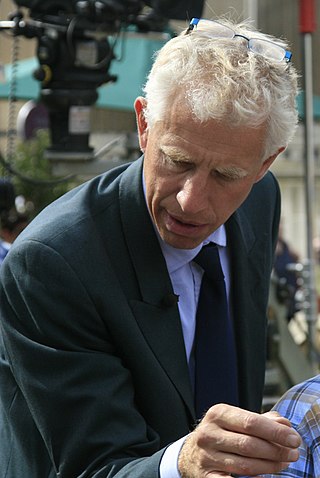
Thomas Patrick Keating (1917–1984) was an English artist, art restorer and art forger. Considered the most prolific and versatile art forger of the 20th century, he claimed to have faked more than 2,000 paintings by over 160 different artists of unprecedented scope—ranging from the Renaissance to Modernism, Expressionism and Fauvism —with heavy emphasis on English landscape Romanticists and the French Impressionists. Total estimated profits from his forgeries amount in today's value to more than $10 million.

The Courtauld Institute of Art, commonly referred to as The Courtauld, is a self-governing college of the University of London specialising in the study of the history of art and conservation. It is among the most prestigious specialist colleges for the study of the history of art in the world and is known for the disproportionate number of directors of major museums drawn from its small body of alumni.

Antiques Roadshow is a British television programme broadcast by the BBC in which antiques appraisers travel to various regions of the United Kingdom to appraise antiques brought in by local people. It has been running since 1979, based on a 1977 documentary programme.

Art forgery is the creation and sale of works of art which are falsely credited to other, usually more famous artists. Art forgery can be extremely lucrative, but modern dating and analysis techniques have made the identification of forged artwork much simpler.

Thomas William Roberts was an English-born Australian artist and a key member of the Heidelberg School art movement, also known as Australian impressionism.

F for Fake is a 1973 docudrama film co-written, directed by, and starring Orson Welles who worked on the film alongside François Reichenbach, Oja Kodar, and Gary Graver. Initially released in 1974, it focuses on Elmyr de Hory's recounting of his career as a professional art forger; de Hory's story serves as the backdrop for a meandering investigation of the natures of authorship and authenticity, as well as the basis of the value of art. Far from serving as a traditional documentary on de Hory, the film also incorporates Welles's companion Oja Kodar, hoax biographer Clifford Irving and Orson Welles as himself. F for Fake is sometimes considered an example of a film essay.

The Massacre of the Innocents is the subject of two paintings by Peter Paul Rubens depicting the episode of the biblical Massacre of the Innocents of Bethlehem, as related in the Gospel of Matthew (2:13–18). The first, measuring 142 x 182 cm, was painted after his return to his native Antwerp in 1608, following eight years spent in Italy.

Clementine Hunter was a self-taught Black folk artist from the Cane River region of Louisiana, who lived and worked on Melrose Plantation.
Shaun Greenhalgh is a British artist and former art forger. Over a seventeen-year period, between 1989 and 2006, he produced a large number of forgeries. With the assistance of his brother and elderly parents, who fronted the sales side of the operation, he successfully sold his fakes internationally to museums, auction houses, and private buyers, accruing nearly £1 million.
Lars Broholm Tharp is a Danish-born British historian, lecturer and broadcaster, and one of the longest running 'experts' on the BBC antiques programme, Antiques Roadshow, first appearing in 1986.

Rupert Nicholas Maas is an English painting specialist and gallery owner best known for his appearances on the long-running BBC One series Antiques Roadshow where he has been a member of the team of experts since 1997.

Philip Jonathan Clifford Mould is an English art dealer, London gallery owner, art historian, writer and broadcaster. He has made a number of major art discoveries, including works of Thomas Gainsborough, Anthony Van Dyck and Thomas Lawrence.

Bords de la Seine à Argenteuil is an oil painting by an unknown artist. The painting is a landscape depicting the River Seine at Argenteuil in France. It is owned by Englishman David Joel.

The Procuress is the name given to a number of similar paintings by the Dutch Golden Age painter Dirck van Baburen. The painting is in the Caravaggiesque style of the Utrecht school.

Fake or Fortune? is a BBC One documentary television series which examines the provenance and attribution of notable artworks. Since the first series aired in 2011, Fake or Fortune? has drawn audiences of up to 5 million viewers in the UK, the highest for an arts show in that country.

M. Knoedler & Co. was an art dealership in New York City founded in 1846. When it closed in 2011, amid lawsuits for fraud, it was one of the oldest commercial art galleries in the US, having been in operation for 165 years.
Treasure Detectives is a television series on CNBC. The reality show covers the search for expensive paintings by a group of art collectors, led by Curtis Dowling, a UK based fakes and forgeries expert. He has appeared on numerous BBC, ITV and Channel 4 shows.

The Grand Teddy tea-rooms paintings is a collective name for three glue distemper oval paintings executed by Édouard Vuillard for Le Grand Teddy tea-rooms in Paris in 1918. The largest is privately owned, but is sometimes exhibited. One of the smaller works was featured on an episode of the BBC television programme Fake or Fortune? which first broadcast on 19 January 2014. The location of the third is currently unknown.

Saint Amelia, Queen of Hungary is an oil painting by Paul Delaroche which was investigated in 2016 by the BBC TV programme Fake or Fortune?

Simon Rollo Gillespie is a British conservator-restorer of fine art, and an art historian. He is known particularly for his work with Early British and Tudor portraits, although his practice extends across all periods from early paintings to contemporary artworks. Gillespie has been restoring art since 1978, and he appears frequently on the BBC Four series Britain's Lost Masterpieces, having previously appeared on the BBC1 art programme Fake or Fortune.
















